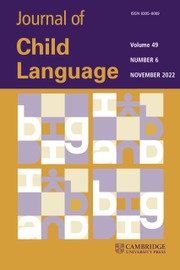Article contents
The interface between neighborhood density and optional infinitives: normal development and Specific Language Impairment*
Published online by Cambridge University Press: 29 November 2011
Abstract
The effect of neighborhood density on optional infinitives was evaluated for typically developing (TD) children and children with Specific Language Impairment (SLI). Forty children, twenty in each group, completed two production tasks that assessed third person singular production. Half of the sentences in each task presented a dense verb, and half presented a sparse verb. Children's third person singular accuracy was compared across dense and sparse verbs. Results showed that the TD group was significantly less likely to use optional infinitives with dense, rather than sparse verbs. In contrast, the distribution of optional infinitives for the SLI group was independent of verb neighborhood density. Follow-up analyses showed that the lack of neighborhood density effect for the SLI group could not be attributed to heterogeneous neighborhood density effects or floor effects. Results were interpreted within the Optional Infinitive/Extended Optional Infinitive accounts for typical language development and SLI for English-speaking children.
Information
- Type
- Articles
- Information
- Copyright
- Copyright © Cambridge University Press 2011
Footnotes
Jill R. Hoover, Child Language Doctoral Program, University of Kansas; Holly L. Storkel, Department of Speech, Language, Hearing: Sciences and Disorders, University of Kansas; Mabel L. Rice, Child Language Doctoral Program, University of Kansas. Jill R. Hoover is now at the Department of Speech & Hearing Sciences, Indiana University.
This research was supported by NIH grants awarded to The University of Kansas: F31 DC009135 (PI: Jill R. Hoover), R01 DC08095 (PI: Holly L. Storkel), P30 DC05803 (PI: Mabel L. Rice), R01 DC001803 (PI: Mabel L. Rice), R01DC005226 (PI: Mabel L. Rice), and T32DC000052 (PI: Mabel Rice); The University of Kansas Intellectual and Developmental Disabilities Research Center: P30HD02528 (PI: Mabel Rice). Additional NIH support for this research includes grants awarded to Indiana University, Bloomington: T32 DC000012 (PI: David Pisoni) and R01 DC001694 (PI: Judith Gierut).
This research was completed at the University of Kansas as part of Jill Hoover's doctoral dissertation requirements for the Child Language Doctoral Program. Mindy Bridges and Michaela Catlin (University of Kansas) contributed to reliability calculations. We gratefully acknowledge Judith Gierut, at Indiana University, for her valuable feedback and discussions throughout the preparation of this manuscript. We also acknowledge Stephanie Dickinson, from the Indiana Statistical Consulting Center, for her guidance on the statistical analysis of the data.
References
REFERENCES
- 25
- Cited by

